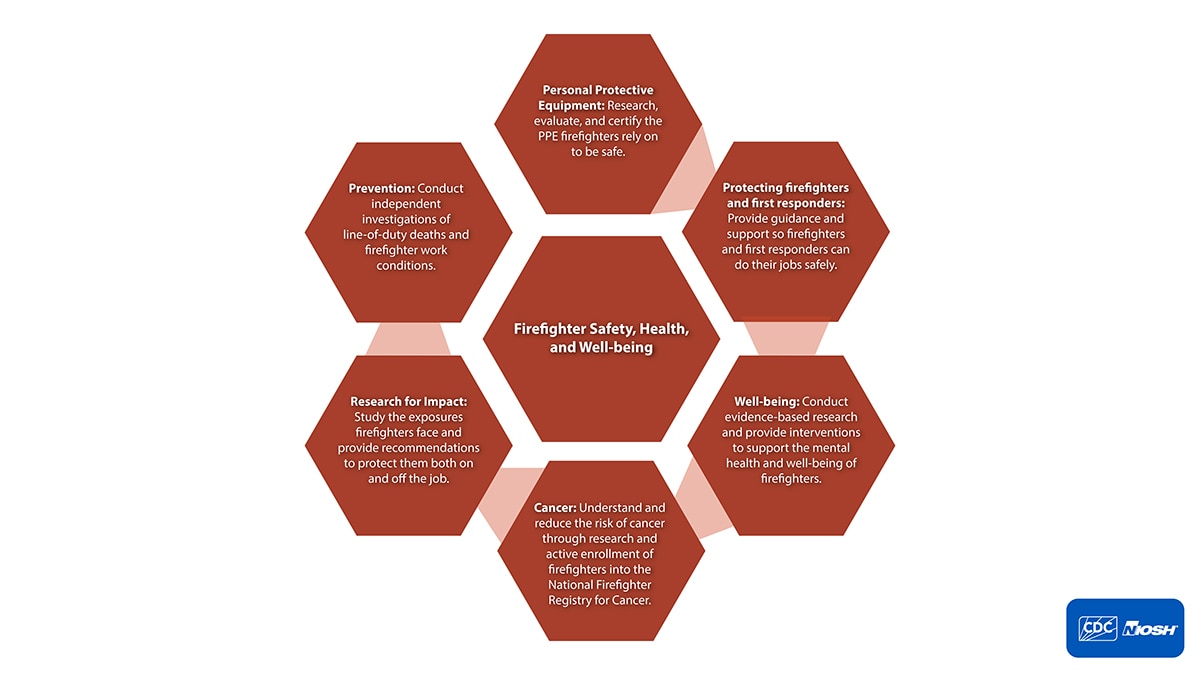Key points
- NIOSH Firefighter safety and health work is represented in all 50 U.S. states and Washington, D.C.
- The Center was established to provide a central point for engaging with the broad spectrum of research and service NIOSH conducts around firefighters.
- Partner involvement is key to our success.

Overview
The NIOSH Center for Firefighter Safety, Health, and Well-being provides a central point for engaging with the broad spectrum of research and service NIOSH conducts around firefighters. The goal of the Center is to better protect firefighters and be able to identify and prevent new and emerging hazards in the fire service earlier and faster.

Firefighters are vital to the safety of our communities and to reducing the risk of adverse events. However, their jobs can put their own safety and health at risk. Beyond injuries and deaths occurring while on duty, structural and wildland firefighters are at risk of cancer and other illnesses.
Protecting firefighters' safety and health is a top priority for NIOSH. NIOSH has decades of experience conducting investigations and research on firefighter safety and health. In addition, as the threat from structural and wildland fires grows both firefighters and other workers face risks from fire-related exposures, such as smoke inhalation, post-fire clean-up activities, and hazardous materials. The Center provides an opportunity to better understand the hazards for those responding to fires as well as those exposed to the effects of fires.
How NIOSH protects firefighters
NIOSH is addressing the top safety and health issues in the fire service:
- Cancer. NIOSH is actively enrolling firefighters into the National Firefighter Registry for Cancer. This is the largest effort ever undertaken to understand and reduce the risk of cancer among U.S. firefighters.
- Hazardous exposures, including PFAS. NIOSH is exploring the materials burned, fire conditions, and the substances used when putting out fires. These include PFAS in firefighting foam and turnout gear. NIOSH is studying the impact on firefighters' exposures and risk levels.
- Line-of-duty deaths. The NIOSH Fire Fighter Fatality Investigation and Prevention Program conducts independent investigations of firefighter line-of-duty deaths and recommends prevention methods.
- Personal protective equipment (PPE). NIOSH evaluates the PPE structural and wildland firefighters rely on to be safe, including respirators and turnout gear. The NIOSH Respirator Approval Program approves the respirators firefighters use.
- Protecting first responders during public health threats. NIOSH experts rapidly deploy to public health threats to help first responders do their jobs safely and to provide guidance.
- Wildland firefighter safety, health, and well-being. NIOSH works with federal partners to study how the unique conditions and hazards wildland firefighters face impact them physically and mentally. The results help to develop preventive measures to reduce their risk.
- Wildland urban interface (WUI). There have been increases in residential development where wildland vegetation and urban areas meet. This has increased the risk of catastrophic fires spreading into urban neighborhoods. NIOSH is working to help fire personnel understand the hazards of WUI smoke and to develop ways to lessen exposure.
What we've accomplished
NIOSH Firefighter safety and health work is represented across the United States. Some highlights include:
- Fatality investigations 750+
- Health hazard evaluations 85+
- Research and other communication products 1,400+
- Respirator approvals 10,000+
- 9/11 responders who receive healthcare, including 17,000 FDNY firefighters 88,000+
Funding recipients
Related extramural funding
Partnerships
NIOSH works closely with other federal agencies, researchers, and fire-service leaders and organizations to improve firefighter safety and health. Some of the ways NIOSH works with partners include:
- Serving as subject matter experts on National Fire Protection Association and other consensus standard setting committees.
- Collaborating on research projects.
- Developing prevention resources and interventions for fire departments, firefighters, and partner organizations.
- Funding specialized firefighter health and safety training delivered by the International Association of Fire Fighters.
Interested parties and partners
Federal
- Occupational Safety and Health Administration
- Department of the Interior
- Fire Administration
- Forest Service
Alliances
- Science to the Station: A Health & Wellness Alliance
- Women's Fire Alliance
Associations
- Fire Department Safety Officers Association
- International Association of Arson Investigators
- International Association of Fire Chiefs
- International Association of Fire Fighters
- National Association of Hispanic Firefighters
- National Fire Protection Association
Other groups
- Congressional Fire Research Institute
- Center for Public Safety Excellence
- Firefighter Cancer Support Network
- Interagency Board for Emergency Preparedness and Response
- National Fallen Firefighters Foundation
- National Volunteer Fire Council
- National Wildfire Coordinating Group
- North American Fire Training Directors
- Underwriters Laboratories, Fire Safety Research Institute
- Urban Fire Forum of the Metropolitan Fire Chiefs
